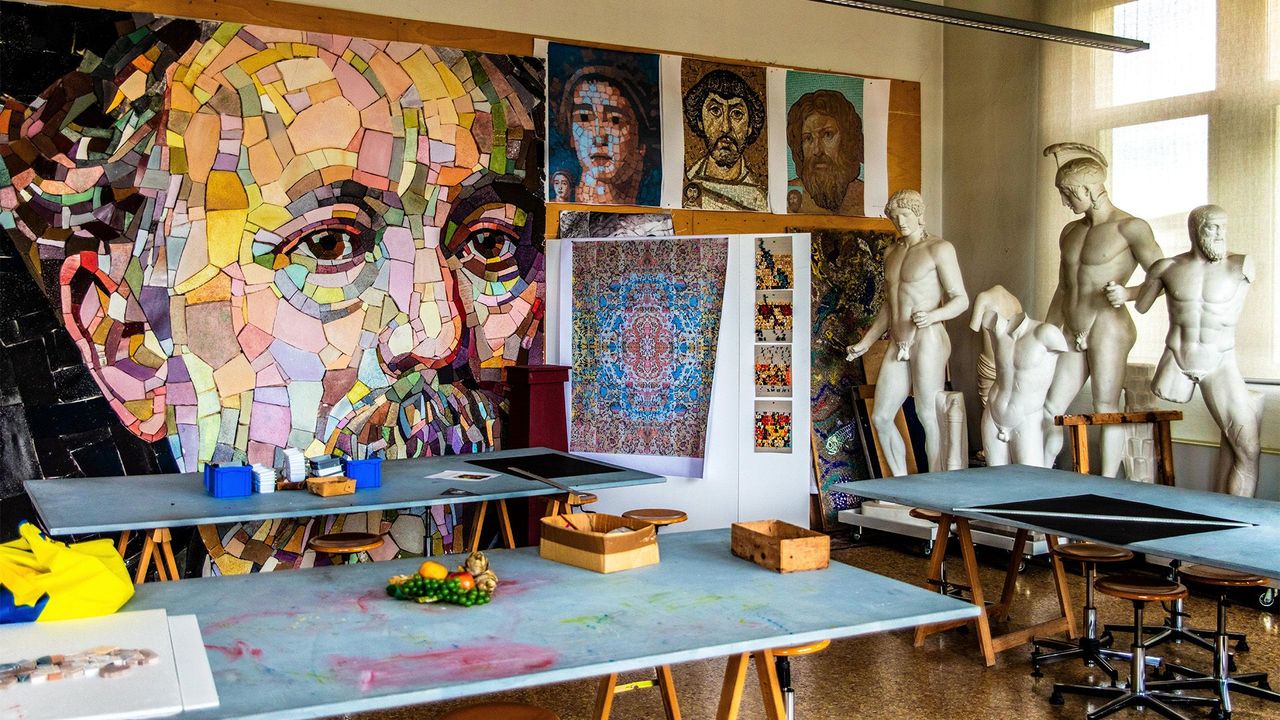Nestled in the northeastern part of Italy, within the region of Friuli Venezia Giulia, exists a craft that has been preserved over centuries in a dedicated school focused entirely on the complex art of creating mosaics. Although Italy is famous globally for its impact on art, architecture, and design, this unique school—largely unfamiliar to those outside specialized groups—stands as a testament to a tradition originating from ancient Rome and Byzantium.
The Scuola Mosaicisti del Friuli, located in Spilimbergo, has been educating expert mosaic artists since the start of the 20th century. While Italy is frequently associated with Renaissance artwork, marble carvings, and magnificent churches, the precise art of mosaics occupies a special niche in the nation’s rich artistic tradition. This modest yet esteemed school is among the last institutions where the craft is imparted in its most authentic manner, maintaining age-old methods handed through the ages while evolving with modern artistic trends.
For those who are not acquainted with the craft, mosaics require meticulously arranging tiny bits of colored glass, stone, pottery, or other substances—referred to as tesserae— to form intricate designs and imagery. This artistic method requires great patience, accuracy, and a profound grasp of arrangement, color harmony, and the characteristics of materials. The outcome is a form that is both visually captivating and remarkably long-lasting, able to endure hundreds of years of use.
The students who enroll in the school come from various parts of Italy and the world, drawn by a shared passion for this intricate craft. Their education spans several years, during which they study not only the technical aspects of mosaic creation but also art history, design, and material science. From large-scale architectural installations to fine art pieces, the versatility of mosaics is explored through hands-on learning under the guidance of seasoned instructors.
Walking through the school’s workshops reveals a vibrant mix of tradition and innovation. Ancient Roman and Byzantine motifs sit alongside modern abstract designs. The sound of hammers gently tapping tesserae into place echoes through the studios as students painstakingly arrange each tiny fragment. It is an environment where the past and present coexist, where age-old skills are being kept alive and reimagined for contemporary audiences.
The significance of this art form goes beyond its visual appeal. Mosaics have historically played roles in religious, political, and societal contexts. From the flooring in Roman mansions to the grand walls of Byzantine cathedrals, mosaics have been utilized to tell stories, highlight religious tales, and exhibit affluence and authority. The academy’s goal is not just to maintain the technical abilities needed to produce mosaics but also to provide insight into their cultural importance.
In our rapidly advancing digital world, the intentional slowness of creating mosaics might appear outdated. However, this is exactly what attracts numerous enthusiasts to this craft. The tactile aspect of the process—the texture of stones, the light reflecting off glass, the creation of a cohesive image from separate pieces—provides a contemplative escape from the fleeting aspects of contemporary existence. For learners and creators, making mosaics is equally about self-discipline and contemplation as it is about creating visual art.
The endurance of these time-honored arts is not without obstacles. In recent years, public knowledge of mosaic art has waned, and financial support for expert craft education has been impacted by wider educational changes. Nevertheless, the institution’s standing and excellence in teaching still draw students and project requests globally. From restoring churches to creating public artworks, alumni of the Scuola Mosaicisti del Friuli engage in projects that underscore the lasting significance of their skill.
In recent years, there has also been a noticeable resurgence of interest in handmade arts and heritage crafts. This renewed appreciation for tangible, enduring art forms has brought mosaics back into the spotlight, not only in Italy but also internationally. Designers, architects, and collectors are once again looking to mosaics as a means of adding texture, depth, and historical reference to modern spaces. The school has played a pivotal role in this renaissance, collaborating with contemporary artists and participating in exhibitions that showcase the versatility of mosaic art.
The task of assembling a mosaic is inherently detailed and requires significant time. Each fragment needs to be sliced, molded, and positioned with precision. Artists must organize their designs ahead of time, yet stay open to adapting to the spontaneous changes presented by natural materials. This blend of preparation and spontaneity turns mosaic crafting into an art form that marries technical proficiency with imaginative instinct.
The techniques taught at the school encompass both traditional direct methods—where tesserae are laid face-up directly onto the final surface—and indirect methods, where pieces are assembled in reverse on temporary surfaces before being transferred. Students learn to work with a variety of materials, from smalti (hand-cut glass pieces) to marble, ceramics, and even recycled or unconventional materials. The inclusion of modern materials reflects the school’s commitment to evolving the art form while remaining grounded in its historical roots.
Preserving cultural heritage is an important part of the school’s mission. Italy, which boasts some of the world’s renowned mosaics, has the constant challenge of maintaining and restoring ancient creations. The skills honed at the Scuola Mosaicisti del Friuli are frequently needed for the restoration of heritage sites, making sure that historical mosaics remain valued by future generations.
The city of Spilimbergo has wholeheartedly taken on the responsibility of safeguarding this historic art form. Public areas, exhibitions, and even regular streets are adorned with mosaic art, forming an atmosphere where art is effortlessly integrated into everyday living. Those who travel to the area can observe the crafting of new artworks as well as the conservation of parts that narrate stories from bygone eras.
For the students who enter the school’s doors, the experience is life-changing. The path from beginner to expert in mosaic art requires patience, skill, and commitment. Numerous students eventually set up their own studios, engage in esteemed restoration ventures, or partner with global artists and architects. The abilities learned are not easily duplicated by machines or through mass manufacturing, ensuring each mosaic remains a distinct and enduring addition to the art world.
The lasting attraction of mosaic art is found in its widespread appeal and versatility. Though originating from age-old customs, mosaics are still developing, being incorporated into today’s design, architecture, and modern art. The Scuola Mosaicisti del Friuli, by maintaining and promoting this legacy, is crucial in keeping the craft of mosaics vibrant and significant in the contemporary world.



